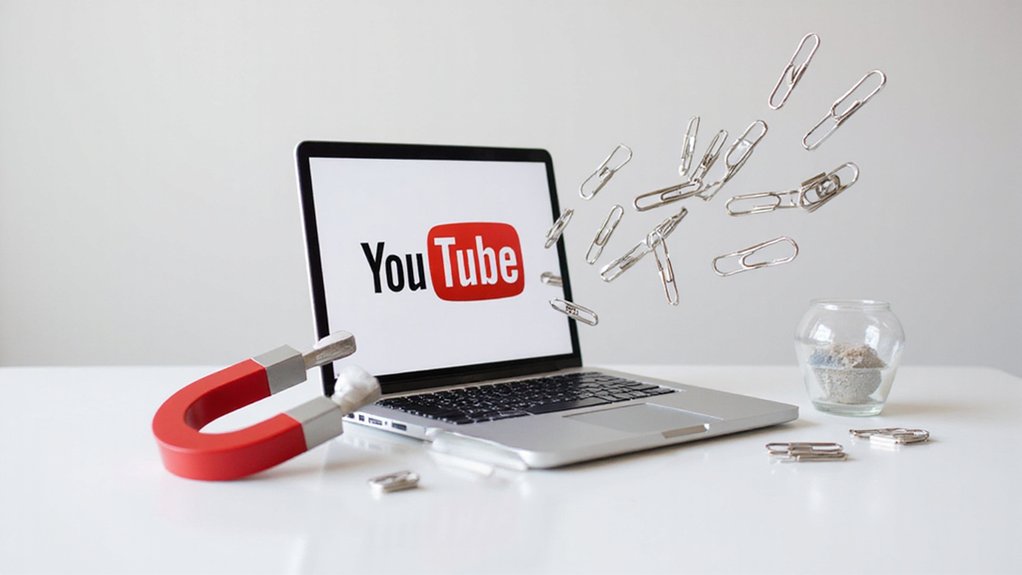Agencies create lead magnets—interactive calculators, templates, or email courses—that solve specific client problems in exchange for contact information, transforming anonymous website visitors into qualified prospects. These resources (which outperform traditional eBooks by up to 155% in conversion rates) pre-qualify leads while demonstrating expertise without cannibalizing core services. Combined with targeted advertising and analytics tracking, lead magnets systematically generate over 1,000 monthly contacts, replacing inefficient cold outreach with inbound prospects who’ve already demonstrated interest—though the strategic nuances determine whether agencies capture genuine opportunities or merely inflate vanity metrics.

Why do agencies persist in chasing prospects through cold outreach and networking events while leaving perfectly qualified leads to stumble upon their services by accident?
The economics of client acquisition suggest a more rational approach: lead magnets that systematically convert browsers into buyers.
Lead magnets—those strategic offerings of valuable content in exchange for contact information—represent perhaps the most underutilized arbitrage opportunity in agency marketing.
Lead magnets create systematic conversion while competitors waste resources on ineffective cold outreach tactics.
While competitors exhaust resources on spray-and-pray tactics, sophisticated agencies deploy targeted eBooks, webinars, templates, and email courses to achieve conversion rate increases of up to 155% on desktop (and 101% on mobile, for those tracking cross-platform performance metrics).
The format selection reveals telling insights about audience psychology.
eBooks, despite their detailed nature, often underperform compared to interactive calculators and quizzes that pre-qualify leads while simultaneously engaging them.
Templates and process documents prove particularly effective for agencies, as they provide immediate solutions that can reduce sales cycles—a phenomenon that should surprise no one familiar with prospect behavior patterns.
For agencies looking to maximize engagement, worksheets or workbooks offer prospects the opportunity to experience tangible benefits from their methodologies before committing to larger investments.
Email courses deserve special consideration for their superior engagement mechanics.
Breaking complex agency methodologies into digestible daily lessons achieves higher completion rates than traditional static content, while creating multiple touchpoints that reinforce the agency’s expertise.
This approach leverages the psychological principle of progressive commitment, where small initial investments lead to larger subsequent decisions.
The measurement component separates amateur efforts from professional campaigns.
Conversion rates, open rates, and completion metrics provide the feedback loops necessary for optimization, yet many agencies operate without proper analytics implementation—a oversight that renders performance improvement practically impossible.
Understanding that lead magnets should solve narrow problems while highlighting expertise becomes crucial for agencies seeking to build trust without cannibalizing their paid consulting services.
Strategic integration amplifies results exponentially.
Agencies that combine targeted advertising with SEO-optimized landing pages and broader content marketing strategies report email list growth exceeding 1,000 new contacts monthly.
The compounding effect becomes apparent when considering that each qualified lead represents potential recurring revenue rather than one-time transaction value.
Forward-thinking agencies now incorporate AI-powered solutions to enhance their lead generation capabilities, with some reporting inbound lead increases of 99% within six months of implementation.
The irony remains that agencies specializing in marketing often neglect their own lead generation systems, preferring the familiar discomfort of active prospecting over the systematic approach of attracting pre-qualified prospects.
Those willing to reverse this tendency discover that clients prefer finding solutions rather than being found by salespeople.
Frequently Asked Questions
How Much Should Agencies Spend on Creating Lead Magnets?
Agencies should allocate 5-15% of their marketing budget to lead magnet creation, though this figure varies considerably by industry sophistication and existing client acquisition costs.
Given average CPLs of $173-198, investing $2,000-5,000 initially makes financial sense—particularly when effective magnets can slash acquisition costs by 90%.
The calculus becomes rather straightforward: spending modestly upfront to potentially eliminate the majority of ongoing lead costs represents sound fiscal stewardship.
What’s the Ideal Length for Agency Lead Magnet Content?
Agency lead magnets perform best within 5-25 pages—a sweet spot balancing perceived value against consumption friction.
Shorter formats (checklists, templates, mini-guides) consistently outperform bloated manifestos that intimidate prospects into abandonment.
The paradox? Agencies often assume more content equals greater authority, yet subscribers prefer digestible, immediately actionable resources.
Length should correlate with complexity: high-value templates require minimal pages, while thorough frameworks justify expanded coverage without overwhelming busy decision-makers seeking quick wins.
How Often Should Agencies Update Their Existing Lead Magnets?
Agencies should refresh lead magnets quarterly, though market dynamics dictate frequency more than arbitrary calendars.
Content relevance deteriorates faster in volatile industries—what resonates today becomes stale tomorrow.
Smart agencies monitor conversion rates (which can drop substantially as market saturation increases) and audience engagement metrics rather than adhering to rigid schedules.
The irony? Many agencies obsess over creation timing while ignoring performance data that screams for immediate updates.
Can Agencies Use the Same Lead Magnet Across Different Industries?
Agencies typically shouldn’t deploy identical lead magnets across disparate industries—a strategy that borders on wishful thinking.
While interactive formats like quizzes demonstrate broader applicability than static content, industry-specific needs invariably trump generic approaches.
Smart agencies leverage AI-driven personalization to adapt core concepts rather than recycling wholesale.
The data overwhelmingly favors tailored content over universal solutions, though clever practitioners can create modular frameworks that maintain relevance while streamlining production costs.
What Legal Considerations Exist When Creating Lead Magnets for Agencies?
Agencies must navigate GDPR and CCPA compliance requirements, ensuring voluntary consent mechanisms separate from lead magnet access—a distinction many overlook until regulators come knocking.
Privacy policies require transparent data collection disclosure, while consent checkboxes must remain unchecked by default (shocking, one must actively choose marketing emails).
The middle-page technique cleverly sidesteps forced opt-ins, though agencies should implement robust data protection measures and maintain updated regulatory compliance tools to avoid costly violations.








